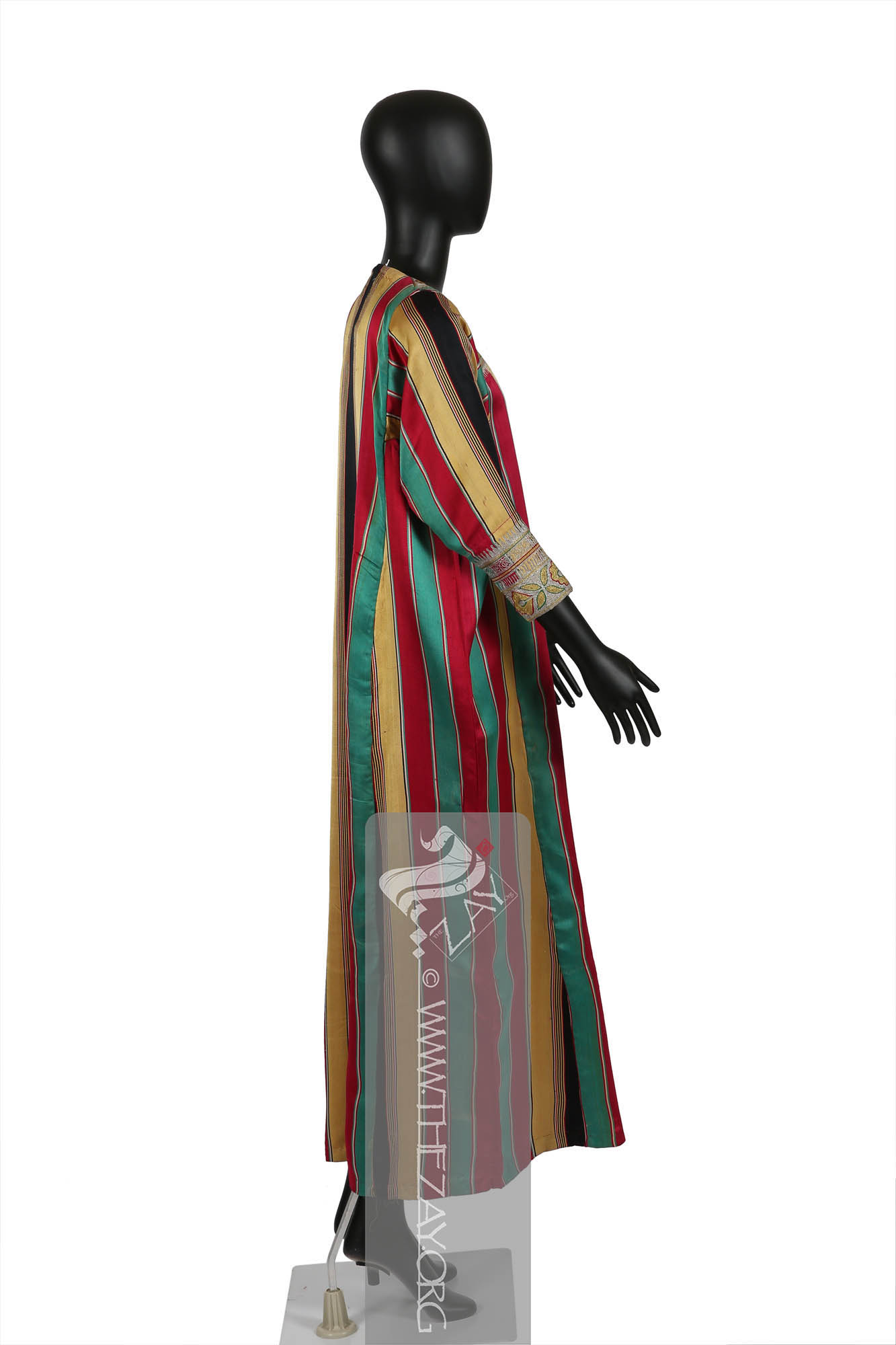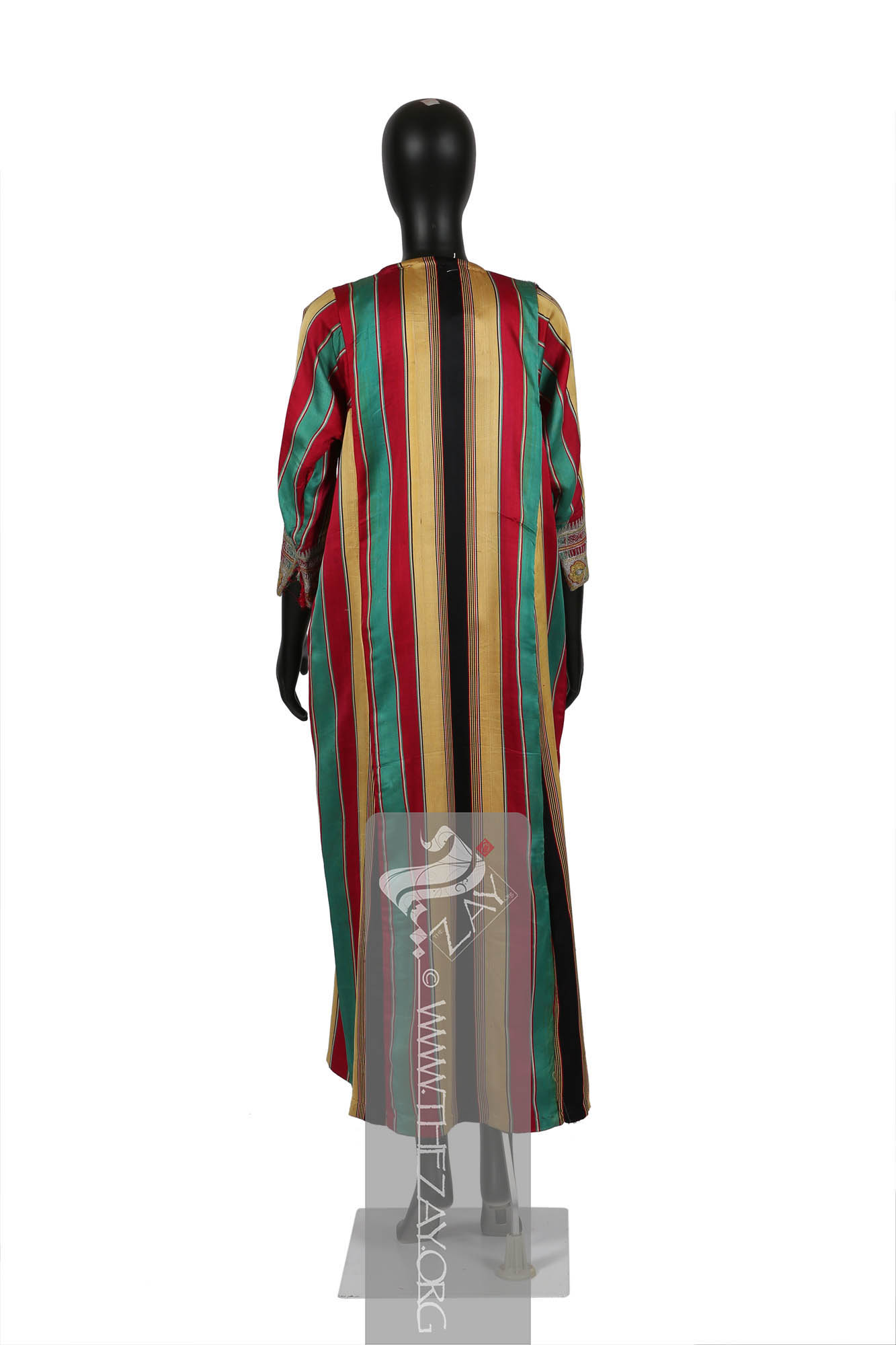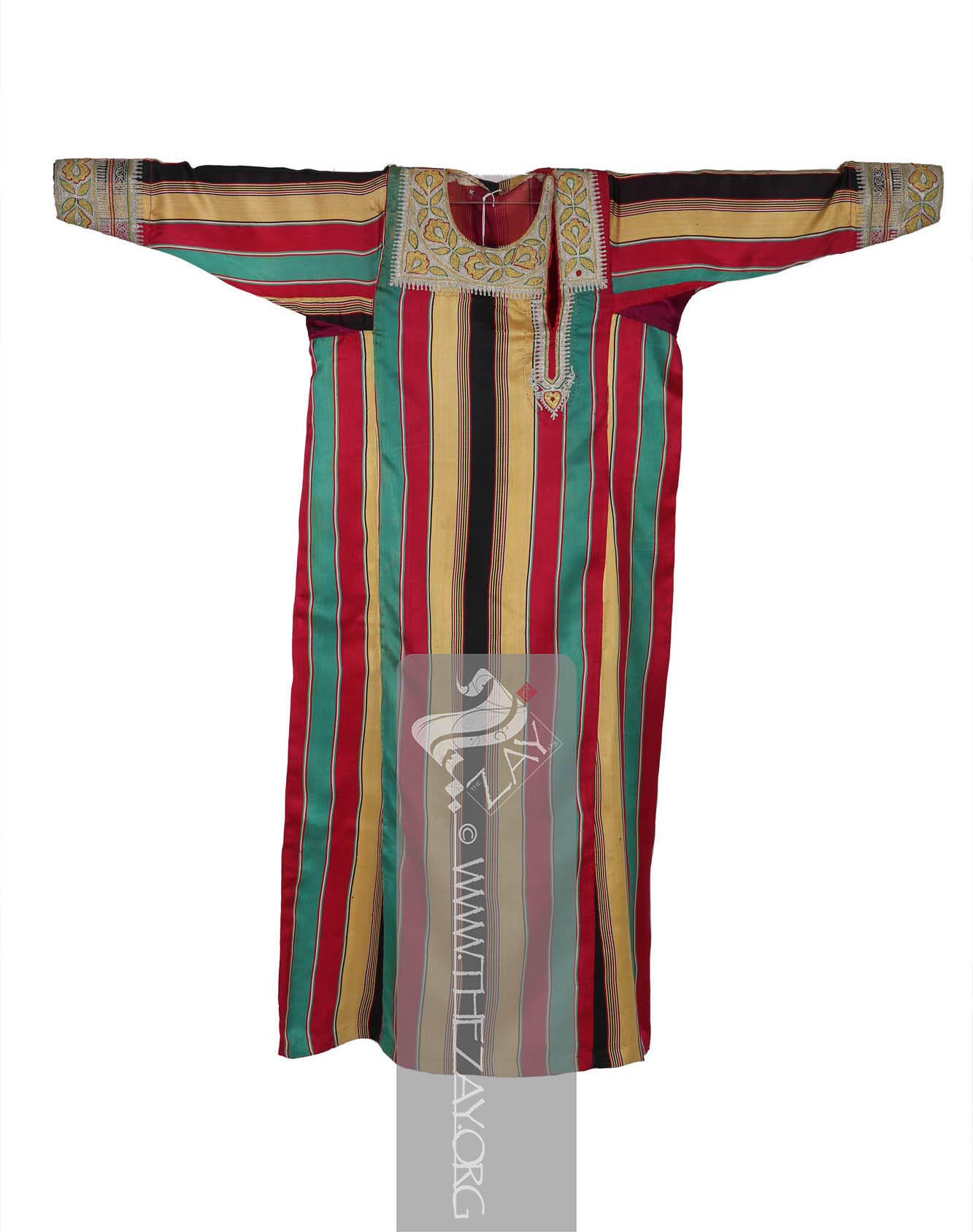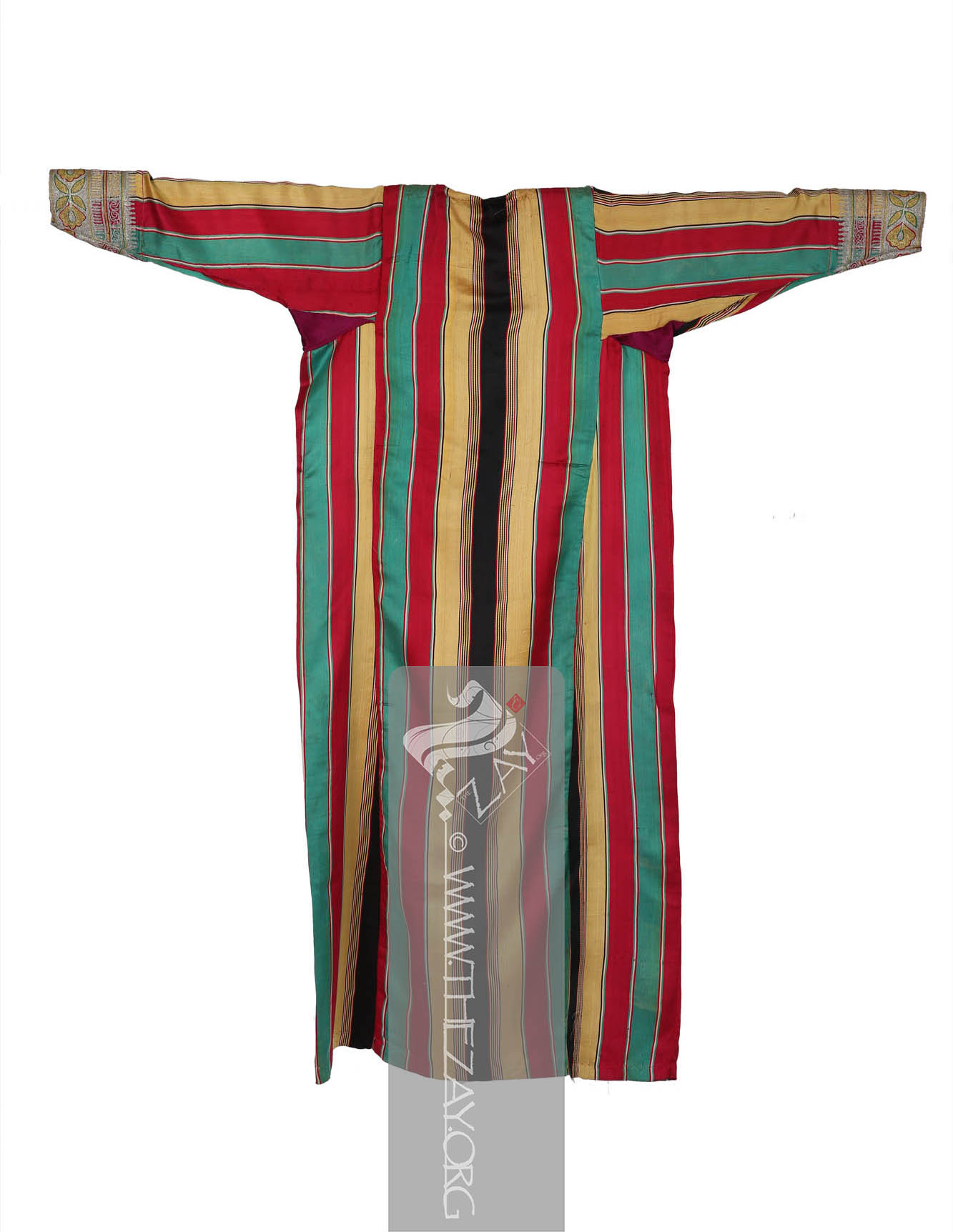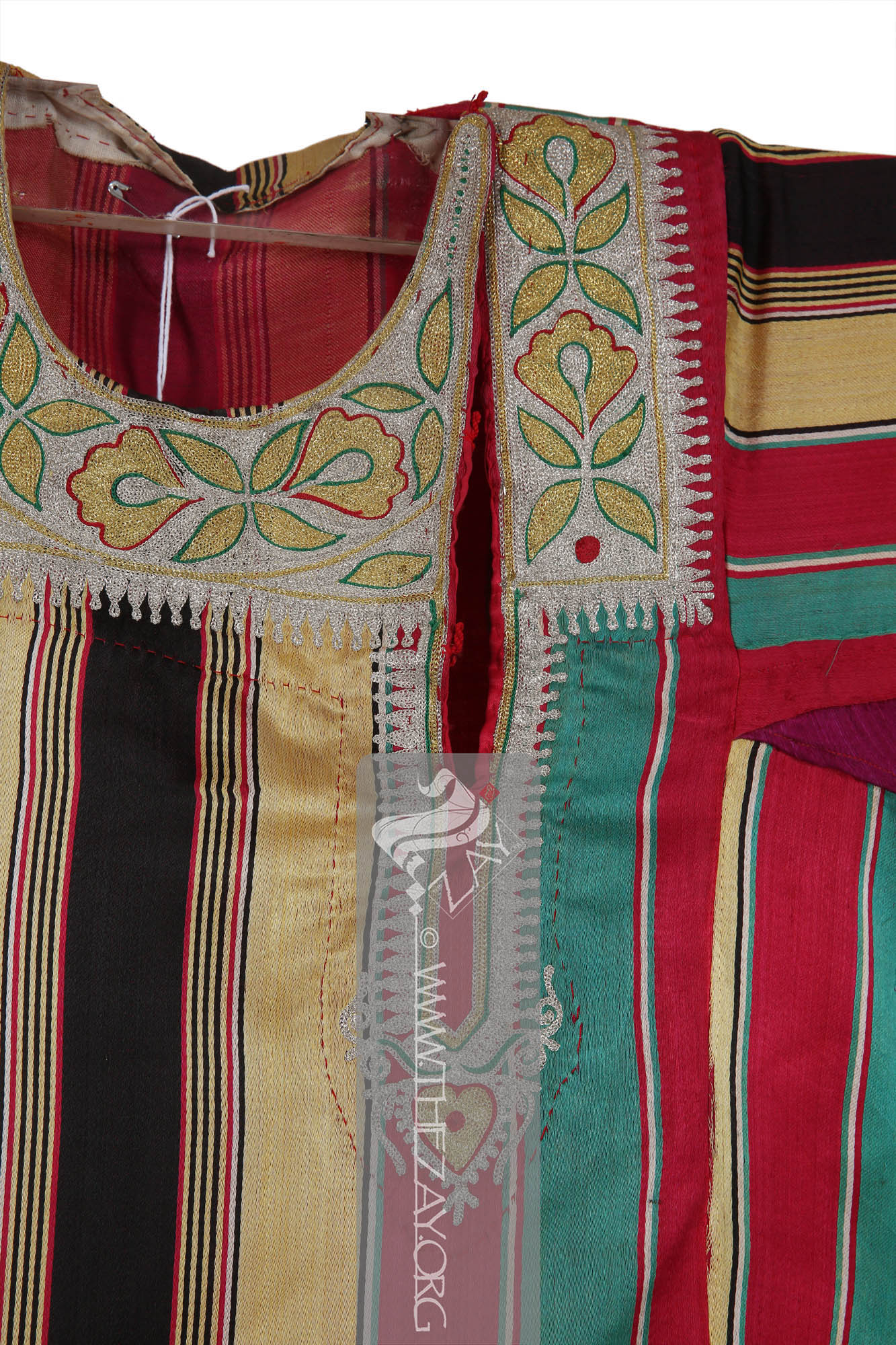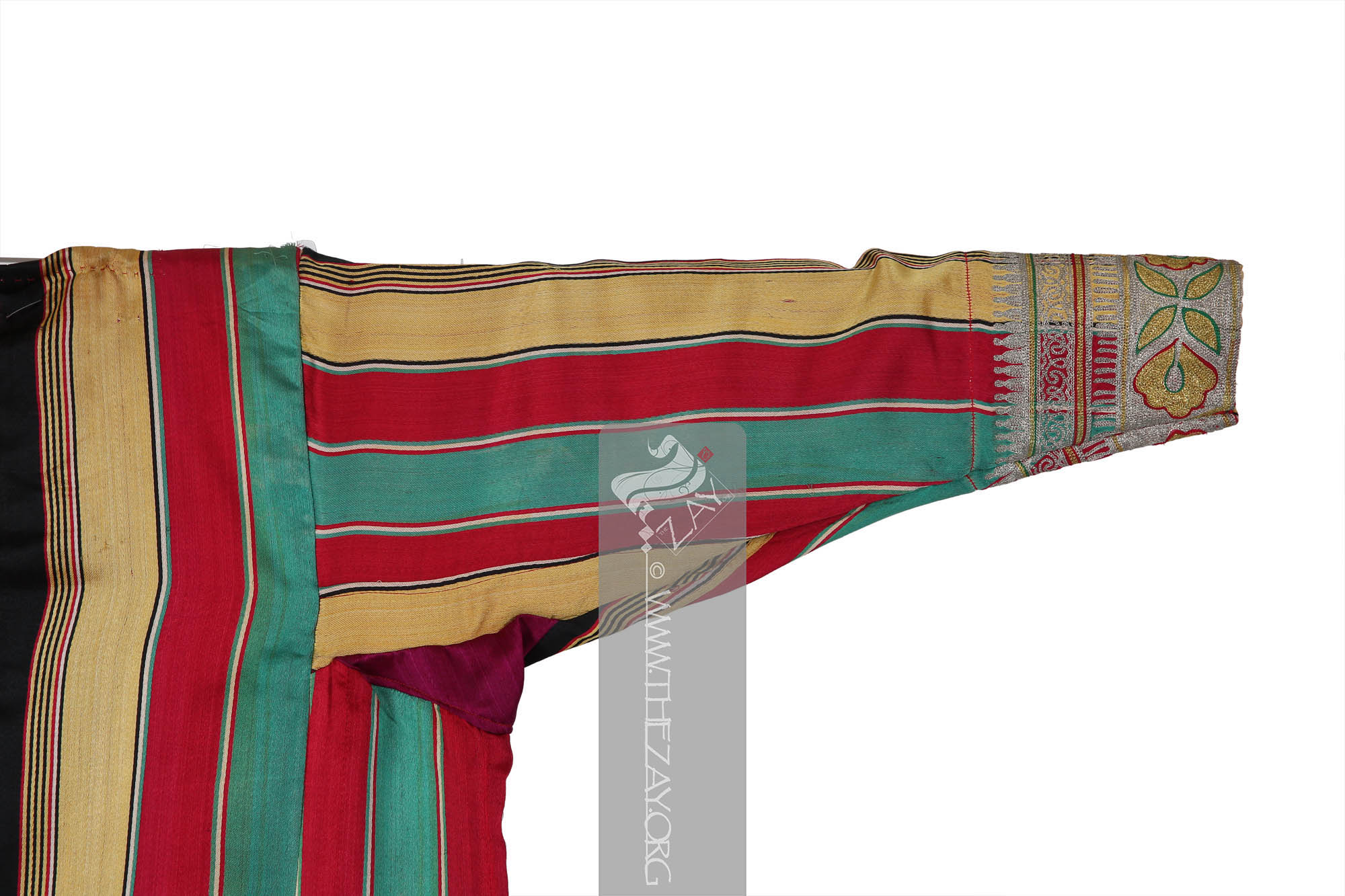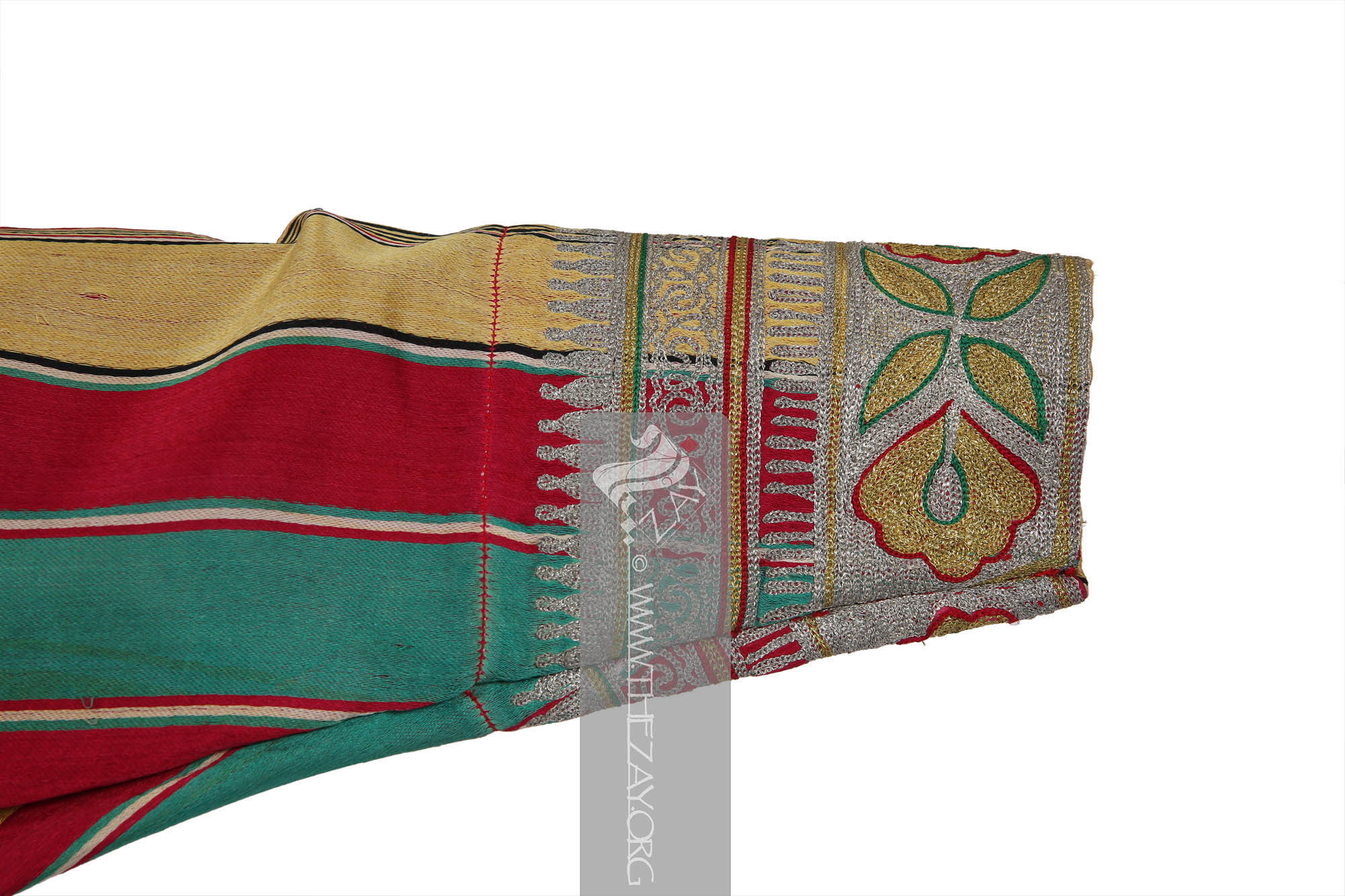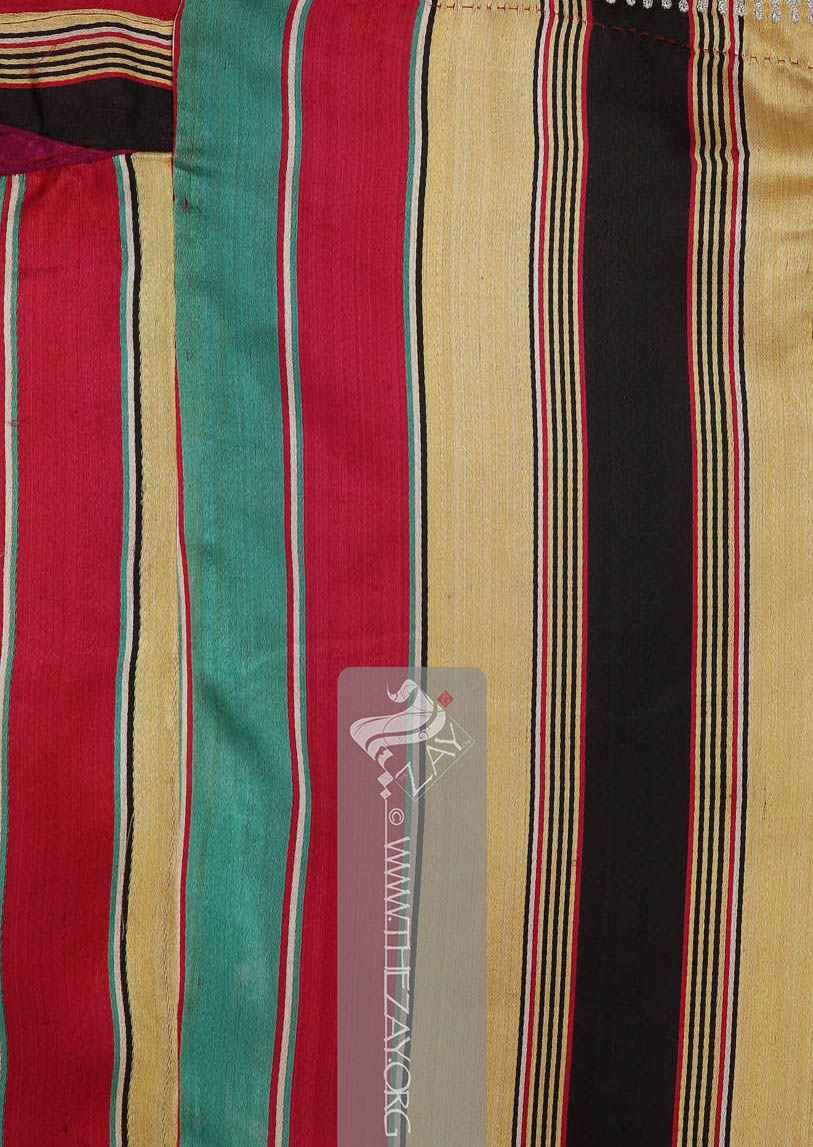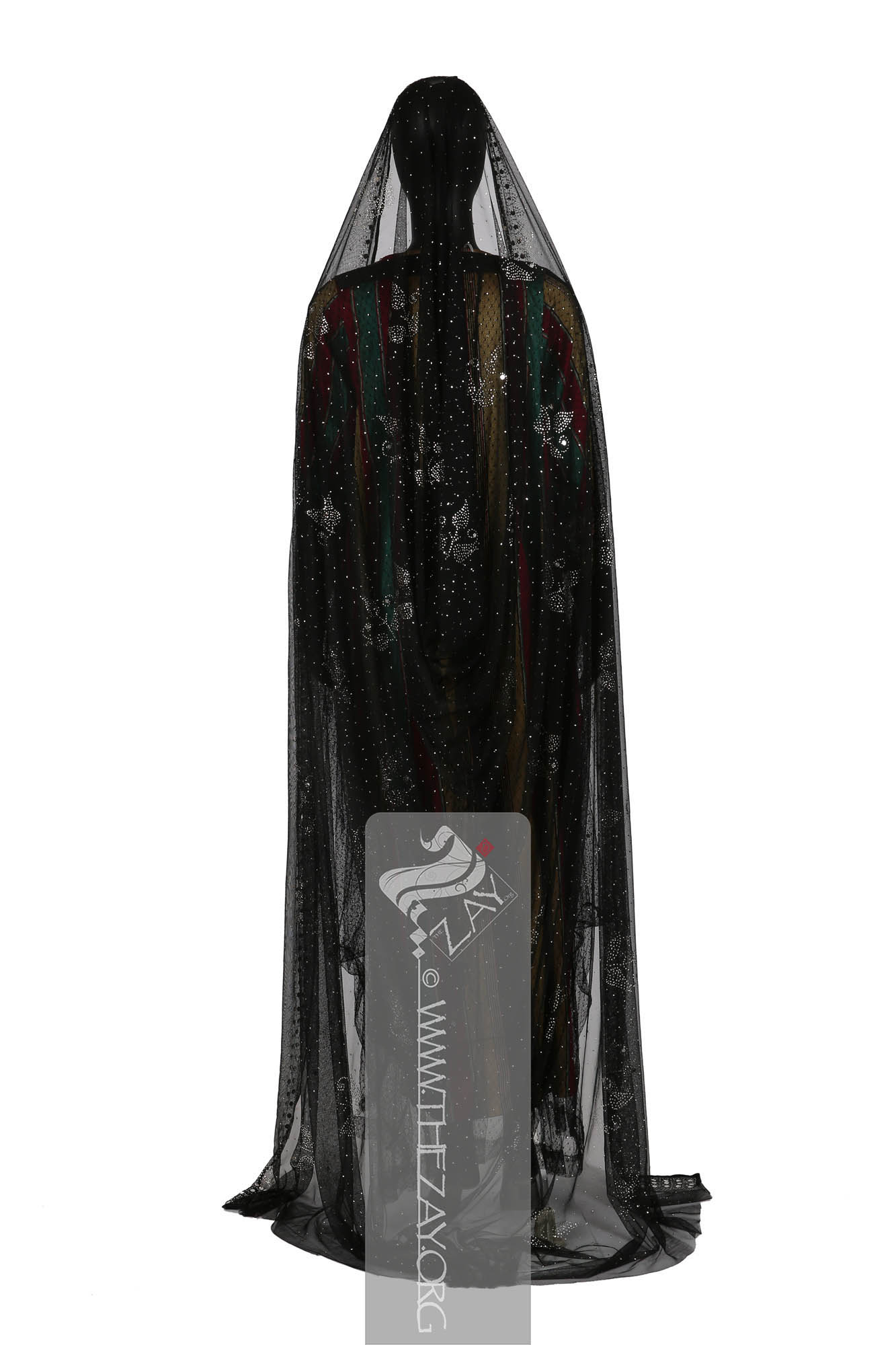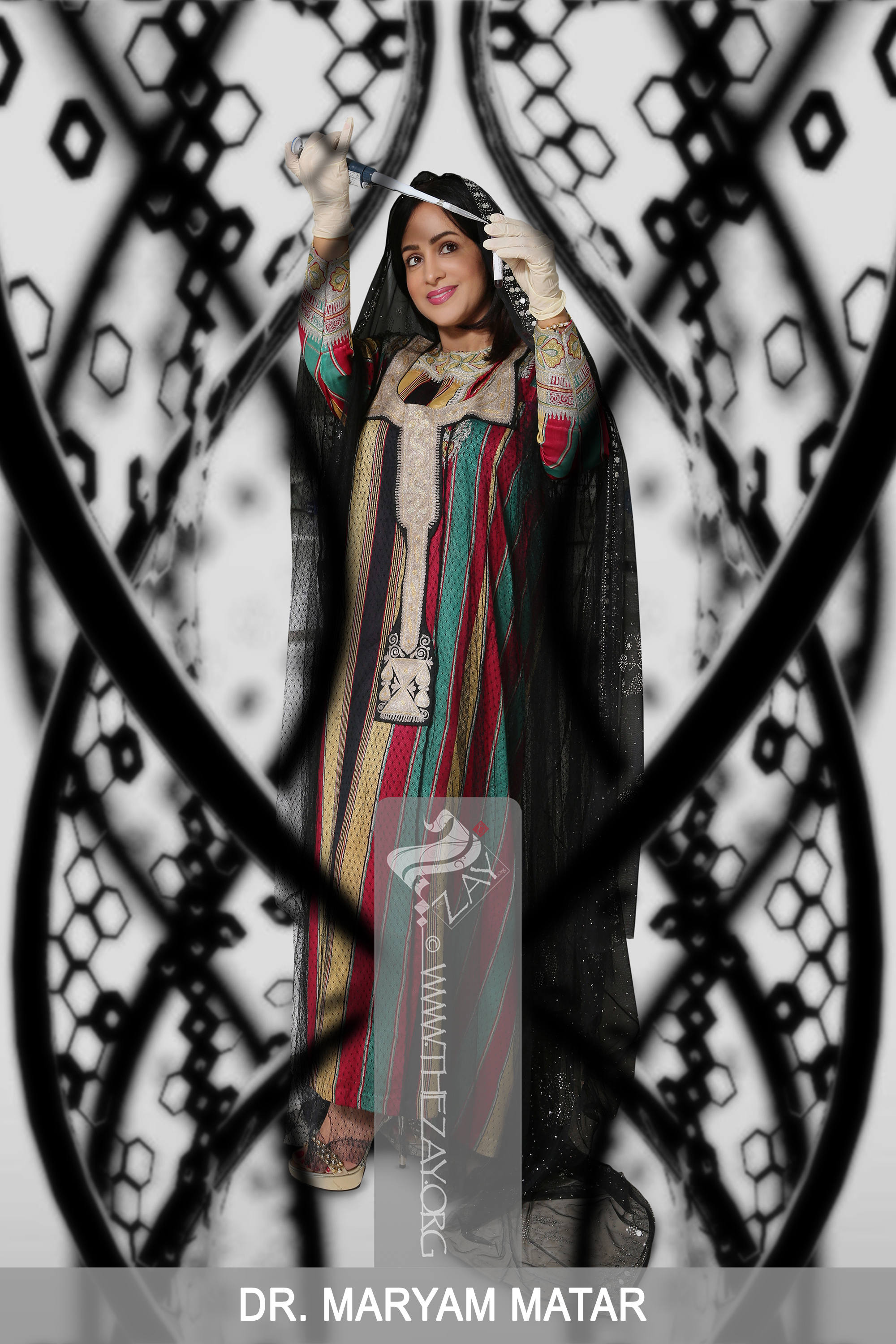Object History In 2018
Dr. Reem Tariq
Ṭariq: (Arabic; Synonym: tulle_bi_talli
Tūlle_bi_tallī: (French: Tulle – a city in France where fine material for veil was first made; Turkish: tel – wire; Synonym: tariq; talli; badla; khus_dozi ), series of small metal knots made on a woven net ground as embellishment. The term is commonly used in the North African Arab region specifically in Egypt.
; talli; badla; khus_dozi ), series of small metal knots made on a woven net ground as embellishment. The term is commonly used in the Levant Arab region specifically in Lebanon.
el Mutwalli
Dr. Reem Tariq
Ṭariq: (Arabic; Synonym: tulle_bi_talli
Tūlle_bi_tallī: (French: Tulle – a city in France where fine material for veil was first made; Turkish: tel – wire; Synonym: tariq; talli; badla; khus_dozi ), series of small metal knots made on a woven net ground as embellishment. The term is commonly used in the North African Arab region specifically in Egypt.
; talli; badla; khus_dozi ), series of small metal knots made on a woven net ground as embellishment. The term is commonly used in the Levant Arab region specifically in Lebanon.
el Mutwallī: Founder (CEO) of the Zay
Zay: (Arabic: costume, Pl. azyaā’), a set of clothes in a style typical of a particular country or historical period. Initiative, a public figure, speaker and author. An expert curator and consultant in Islamic art and architecture, interior design, historic costume, and UAE heritage. was contacted by one of her Instagram followers, Maitha Bakhit, who wished to donate something in memory of her late grandmother, Salamah Bakhit al Ali. She had passed away in 2015 and, following custom, her belongings were being donated to charity. Yet, she had held on to this tunic dress (
kandurah
Kandūrah: (Arabic: qandūrah, pl. kanādīr, synonyms: ghandurah, qandurah
Qandūrah: (Arabic, pl. qanādīr, synonyms: ghandurah, darā’ah, dishdāshah, jalābah, jallābīyah, qaftan, mqta’, thawb
Thawb: (Arabic: thawb, Pl. Athwāb/thībān), can be pronounced thobe
Thobe: (Arabic: thawb, Pl. Athwāb/thībān), can be pronounced thawb or tobe
Tobe: (Arabic: thawb, Pl. Athwāb/thībān), can be pronounced thawb or thobe based on locale. The standard Arabic word for ‘fabric’ or ‘garment’. It can refer to a qamīs-like tunic worn by men and women in the Arabian Peninsula, Iraq, the southern and south-western ports and islands of Iran, and some countries in East and West Africa. More specifically, it can refer to the square-shaped Bedouin overgarment worn by women. based on locale. The standard Arabic word for ‘fabric’ or ‘garment’. It can also refer to a qamīs-like tunic worn by men and women in the Arabian Peninsula, Iraq, the southern and south-western ports and islands of Iran, and some countries in East and West Africa. More specifically, it can refer to the square-shaped Bedouin overgarment worn by women. or tobe
Tobe: (Arabic: thawb, Pl. Athwāb/thībān), can be pronounced thawb or thobe based on locale. The standard Arabic word for ‘fabric’ or ‘garment’. It can refer to a qamīs-like tunic worn by men and women in the Arabian Peninsula, Iraq, the southern and south-western ports and islands of Iran, and some countries in East and West Africa. More specifically, it can refer to the square-shaped Bedouin overgarment worn by women. based on locale. The standard Arabic word for ‘fabric’ or ‘garment’. It can also refer to a qamīs-like tunic worn by men and women in the Arabian Peninsula, Iraq, the southern and south-western ports and islands of Iran, and some countries in East and West Africa. More specifically, it can refer to the square-shaped Bedouin overgarment worn by women in the Arabian Gulf region. or tobe
Tobe: (Arabic: thawb, Pl. Athwāb/thībān), can be pronounced thawb or thobe based on locale. The standard Arabic word for ‘fabric’ or ‘garment’. It can refer to a qamīs-like tunic worn by men and women in the Arabian Peninsula, Iraq, the southern and south-western ports and islands of Iran, and some countries in East and West Africa. More specifically, it can refer to the square-shaped Bedouin overgarment worn by women. ), a loose, short or long-sleeved, shirt like (qamis) tunic with frontal neckline opening, worn by both sexes. Each Arab region has a different term for what is essentially a similar garment with various small differences. , dra’ah, dishdāshah, jallābīyah, jalābah, jillābīyah, qaftan
Qafṭān: (Persian: khaftān, Pl. qafāṭin, synonyms: ghandurah, qandurah
Qandūrah: (Arabic, pl. qanādīr, synonyms: ghandurah, darā’ah, dishdāshah, jalābah, jallābīyah, qaftan, mqta’, thawb
Thawb: (Arabic: thawb, Pl. Athwāb/thībān), can be pronounced thobe
Thobe: (Arabic: thawb, Pl. Athwāb/thībān), can be pronounced thawb or tobe
Tobe: (Arabic: thawb, Pl. Athwāb/thībān), can be pronounced thawb or thobe based on locale. The standard Arabic word for ‘fabric’ or ‘garment’. It can refer to a qamīs-like tunic worn by men and women in the Arabian Peninsula, Iraq, the southern and south-western ports and islands of Iran, and some countries in East and West Africa. More specifically, it can refer to the square-shaped Bedouin overgarment worn by women. based on locale. The standard Arabic word for ‘fabric’ or ‘garment’. It can also refer to a qamīs-like tunic worn by men and women in the Arabian Peninsula, Iraq, the southern and south-western ports and islands of Iran, and some countries in East and West Africa. More specifically, it can refer to the square-shaped Bedouin overgarment worn by women. or tobe
Tobe: (Arabic: thawb, Pl. Athwāb/thībān), can be pronounced thawb or thobe based on locale. The standard Arabic word for ‘fabric’ or ‘garment’. It can refer to a qamīs-like tunic worn by men and women in the Arabian Peninsula, Iraq, the southern and south-western ports and islands of Iran, and some countries in East and West Africa. More specifically, it can refer to the square-shaped Bedouin overgarment worn by women. based on locale. The standard Arabic word for ‘fabric’ or ‘garment’. It can also refer to a qamīs-like tunic worn by men and women in the Arabian Peninsula, Iraq, the southern and south-western ports and islands of Iran, and some countries in East and West Africa. More specifically, it can refer to the square-shaped Bedouin overgarment worn by women in the Arabian Gulf region. or tobe
Tobe: (Arabic: thawb, Pl. Athwāb/thībān), can be pronounced thawb or thobe based on locale. The standard Arabic word for ‘fabric’ or ‘garment’. It can refer to a qamīs-like tunic worn by men and women in the Arabian Peninsula, Iraq, the southern and south-western ports and islands of Iran, and some countries in East and West Africa. More specifically, it can refer to the square-shaped Bedouin overgarment worn by women. ), a loose, short or long-sleeved, shirt like (qamis) tunic with frontal neckline opening, worn by both sexes. Each Arab region has a different term for what is essentially a similar garment with various small differences. , drā’ah, dishdāshah, jalābah, jallābīyah, kandurah, mqta’, thawb
Thawb: (Arabic: thawb, Pl. Athwāb/thībān), can be pronounced thobe
Thobe: (Arabic: thawb, Pl. Athwāb/thībān), can be pronounced thawb or tobe
Tobe: (Arabic: thawb, Pl. Athwāb/thībān), can be pronounced thawb or thobe based on locale. The standard Arabic word for ‘fabric’ or ‘garment’. It can refer to a qamīs-like tunic worn by men and women in the Arabian Peninsula, Iraq, the southern and south-western ports and islands of Iran, and some countries in East and West Africa. More specifically, it can refer to the square-shaped Bedouin overgarment worn by women. based on locale. The standard Arabic word for ‘fabric’ or ‘garment’. It can also refer to a qamīs-like tunic worn by men and women in the Arabian Peninsula, Iraq, the southern and south-western ports and islands of Iran, and some countries in East and West Africa. More specifically, it can refer to the square-shaped Bedouin overgarment worn by women. or tobe
Tobe: (Arabic: thawb, Pl. Athwāb/thībān), can be pronounced thawb or thobe based on locale. The standard Arabic word for ‘fabric’ or ‘garment’. It can refer to a qamīs-like tunic worn by men and women in the Arabian Peninsula, Iraq, the southern and south-western ports and islands of Iran, and some countries in East and West Africa. More specifically, it can refer to the square-shaped Bedouin overgarment worn by women. based on locale. The standard Arabic word for ‘fabric’ or ‘garment’. It can also refer to a qamīs-like tunic worn by men and women in the Arabian Peninsula, Iraq, the southern and south-western ports and islands of Iran, and some countries in East and West Africa. More specifically, it can refer to the square-shaped Bedouin overgarment worn by women in the Arabian Gulf region. or tobe
Tobe: (Arabic: thawb, Pl. Athwāb/thībān), can be pronounced thawb or thobe based on locale. The standard Arabic word for ‘fabric’ or ‘garment’. It can refer to a qamīs-like tunic worn by men and women in the Arabian Peninsula, Iraq, the southern and south-western ports and islands of Iran, and some countries in East and West Africa. More specifically, it can refer to the square-shaped Bedouin overgarment worn by women. ) loose, short or long-sleeved, shirt like (qamis
Qamīṣ: (Possibly late Latin: Camisia – Linen Undergarment; Synonym: Kamiz), a traditional loose fitting long tunic or shirt worn by both men and women in South and Central Asia and the Arab world. Typically extending below the waist it is usually paired with a pair of trousers.
) tunic with frontal neckline opening. Each Arab region has a different term for what is essentially a similar garment with various small differences. , mqta’, thawb
Thawb: (Arabic: thawb, Pl. Athwāb/thībān), can be pronounced thobe
Thobe: (Arabic: thawb, Pl. Athwāb/thībān), can be pronounced thawb or tobe
Tobe: (Arabic: thawb, Pl. Athwāb/thībān), can be pronounced thawb or thobe based on locale. The standard Arabic word for ‘fabric’ or ‘garment’. It can refer to a qamīs-like tunic worn by men and women in the Arabian Peninsula, Iraq, the southern and south-western ports and islands of Iran, and some countries in East and West Africa. More specifically, it can refer to the square-shaped Bedouin overgarment worn by women. based on locale. The standard Arabic word for ‘fabric’ or ‘garment’. It can also refer to a qamīs-like tunic worn by men and women in the Arabian Peninsula, Iraq, the southern and south-western ports and islands of Iran, and some countries in East and West Africa. More specifically, it can refer to the square-shaped Bedouin overgarment worn by women. or tobe
Tobe: (Arabic: thawb, Pl. Athwāb/thībān), can be pronounced thawb or thobe based on locale. The standard Arabic word for ‘fabric’ or ‘garment’. It can refer to a qamīs-like tunic worn by men and women in the Arabian Peninsula, Iraq, the southern and south-western ports and islands of Iran, and some countries in East and West Africa. More specifically, it can refer to the square-shaped Bedouin overgarment worn by women. based on locale. The standard Arabic word for ‘fabric’ or ‘garment’. It can also refer to a qamīs-like tunic worn by men and women in the Arabian Peninsula, Iraq, the southern and south-western ports and islands of Iran, and some countries in East and West Africa. More specifically, it can refer to the square-shaped Bedouin overgarment worn by women in the Arabian Gulf region. or tobe
Tobe: (Arabic: thawb, Pl. Athwāb/thībān), can be pronounced thawb or thobe based on locale. The standard Arabic word for ‘fabric’ or ‘garment’. It can refer to a qamīs-like tunic worn by men and women in the Arabian Peninsula, Iraq, the southern and south-western ports and islands of Iran, and some countries in East and West Africa. More specifically, it can refer to the square-shaped Bedouin overgarment worn by women. ) loose, short or long sleeved, shirt like (qamis
Qamīṣ: (Possibly late Latin: Camisia – Linen Undergarment; Synonym: Kamiz), a traditional loose fitting long tunic or shirt worn by both men and women in South and Central Asia and the Arab world. Typically extending below the waist it is usually paired with a pair of trousers.
) tunic with frontal neckline opening, worn by both sexes. Each Arab region has a different term for what is essentially a similar garment with various small differences.), and luckily it is now part of The
Zay
Zay: (Arabic: costume, Pl. azyaā’), a set of clothes in a style typical of a particular country or historical period. Collection.
Object FeaturesThis rare and specific type of tunic (
kandurah_arabiyah
Kandūrah_‘arabīyah: (colloquial Emirati term), coined post 1990s, to refer to the qamīs-like tunic with vertical slit located on the left side of the neckline extending down the chest. The origins of this slit are believed to lie in the Punjabi (kurta
Kūrtā: (Urdu and Persian: kurtah
Kurtah: (Urdu and Persian: kurta, synonyms: bīchī, gawan, fustān, nafnūf, kirtah), a loose sleeveless shirt of varying lengths, typically falling either just above or somewhere below the knees, with its side-seams left open at the bottom, worn in South Asia, usually with a salwar
Salwar: (Farsi: shalvār; Synonym: ṣarwāl, shirwāl ), trousers featuring tapering ankles and drawstring closure of Central Asian origin. They disseminated in the Indian subcontinent between c.1st-3rd century BCE. Although exact period of its arrival in the Arab world is disputed their widespread adoption is confirmed from the 12th century.
, churidars, or pyjama. In Hijazi dialect, the term refers to a sleeved, waist-cinched dress that comes in different styles, popularly worn since the 1950s.). a sleeveless shirt of varying length, typically falling either just above or somewhere below the knees of the wearer, with its side-seams left open at the bottom.) and is generally fastened using cotton thread ball-like buttons ('igham), or metal snaps (siq_w_bic) which were subsequently replaced by transparent versions.ly replaced by transparent versions.) is particular to the UAE. It sports the typical vertical slit (
shaj
Shaj: (Arabic: shaq), meaning 'a rip or tear’ and refers to the opening at the neckline of a garment, also known as (jayīb). The letter (qaf) is turned (jīm) in many colloquial Arab dialects.) located on the left side of the neckline and extends down the chest.
It represents a fine example of the use of the traditional striped fabric (
sultani
Sulṭānī: (Arabic: sultān: king). In the UAE the term denotes to silk satin fabric in multiple vertical striped colours, commonly used for tunics (kanadir) and underpants (sarāwīl). Also refers to book: Sultani, Traditions Renewed, Changes in women’s traditional dress In the United Arab Emirates during the reign of the late Shaykh Zāyid Bin Sultan āl Nahyān, 1966-2004, By Dr. Reem Tariq
Ṭariq: (Arabic; Synonym: tulle_bi_talli
Tūlle_bi_tallī: (French: Tulle – a city in France where fine material for veil was first made; Turkish: tel – wire; Synonym: tariq; talli; badla; khus_dozi ), series of small metal knots made on a woven net ground as embellishment. The term is commonly used in the North African Arab region specifically in Egypt.
; talli; badla; khus_dozi ), series of small metal knots made on a woven net ground as embellishment. The term is commonly used in the Levant Arab region specifically in Lebanon.
El Mutwalli (2011).) widely popular in the UAE, for both tunics (kanadir) and undergarments (
sarawil
Sarāwīl: (Arabic, sing. sirwāl: pants), the term is thought to come from the Persian (sirbal), (sir) meaning ‘over’ and (bal) meaning ‘the body.’ Baggy trousers with drawstring (nis’ah) fastened at the waistline. Worn by men, women, and children, it can extend from the navel to the knees or feet. In some areas it is called (sharwāl), (sarbāl), and (sirwāl), while in the UAE it is often referred to as (khalag). ). The popularity of this fabric has persisted through time. Though this particular example is no longer found in today’s markets, more contemporary versions remain sought after by older women.
An exceptional example of pure silver and gold plated embroidery (khwar_tulah). Focused along the neckline (
halj
Ḥalj: (Arabic: ḥalq: mouth, pl: ḥlūj,). Colloquially, the term refers to the neckline opening. The letter (qāf) is turned (jīm) in many Arab dialects.) and sleeve-cuffs (
hyul
Ḥyūl: (Arabic: hjūl: to walk or jump), colloquially in the Gulf region, the term refers to the hem of garment or its sleeves. In pronunciation, the (j) turns to (y). ), in simple naïve floral motifs outlined in red silk thread (
brisam
Brīsam: (Persian: Aabrēšam, Syriac: Aprišum
‘Um: (Arabic: mother), a sign of respect or formality, women are not addressed by their own names, rather as mother of, then adding the name of the eldest son as in Um Mohammed. Also can mean: with, for example (‘um mishakhiṣ) meaning with gold embellishment., English: prism). Generally, refers to the finest form of silk thread. Also pronounced (ibrīsam).), and leaf forms outlined in green silk thread
brisam
Brīsam: (Persian: Aabrēšam, Syriac: Aprišum
‘Um: (Arabic: mother), a sign of respect or formality, women are not addressed by their own names, rather as mother of, then adding the name of the eldest son as in Um Mohammed. Also can mean: with, for example (‘um mishakhiṣ) meaning with gold embellishment., English: prism). Generally, refers to the finest form of silk thread. Also pronounced (ibrīsam).. The outline of the square-shaped area surrounding the neckline, where the floral designs are embedded, is then highlighted with a saw-tooth motif (
bruj
Brūj: (Arabic: towers, sing: burj), In the UAE the term refers to the repetitive stepped tower shapes created by embroidery or (tallī) adornment.) line that also wraps around the side slit
shaj
Shaj: (Arabic: shaq), meaning 'a rip or tear’ and refers to the opening at the neckline of a garment, also known as (jayīb). The letter (qaf) is turned (jīm) in many colloquial Arab dialects..
Cotton thread buttons (igam) were used to fasten the neck slit
shaj
Shaj: (Arabic: shaq), meaning 'a rip or tear’ and refers to the opening at the neckline of a garment, also known as (jayīb). The letter (qaf) is turned (jīm) in many colloquial Arab dialects. and sleeve cuffs (
hyul
Ḥyūl: (Arabic: hjūl: to walk or jump), colloquially in the Gulf region, the term refers to the hem of garment or its sleeves. In pronunciation, the (j) turns to (y). ). Though all the eye loops (
ghiram
Ghiram: (Arabic, sing. ghirmah
Ghirmah: (Arabic, pl. ghiram), a looped cotton thread that creates eyelets to fasten buttons such as (’igam) onto garments.), a looped cotton thread that creates eyelets to fasten buttons such as (’igam) onto garments.) that held them are still intact, the original thread buttons (igam) have long gone.





